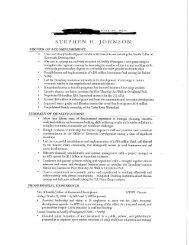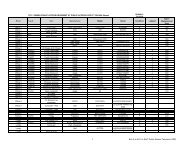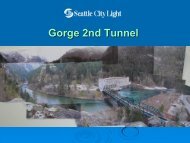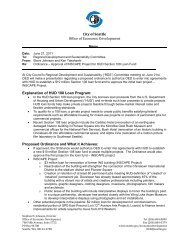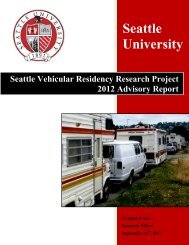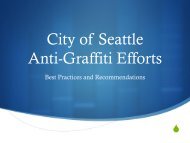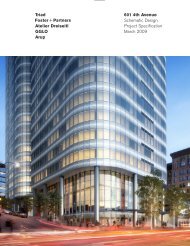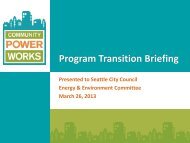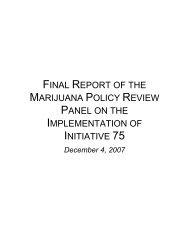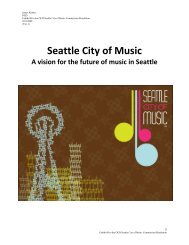2013 Water System Plan, Volume II - Seattle City Clerk's Office - City ...
2013 Water System Plan, Volume II - Seattle City Clerk's Office - City ...
2013 Water System Plan, Volume II - Seattle City Clerk's Office - City ...
Create successful ePaper yourself
Turn your PDF publications into a flip-book with our unique Google optimized e-Paper software.
Chapter 18 <strong>Plan</strong> Review<br />
assigned to a Primary Reviewer. Examples of other <strong>City</strong> plan review are construction of: a new<br />
Fire Station and related infrastructure; a new street with water, sewer and storm mains plus<br />
Green Stormwater Infrastructure (GSI); or a new facility that the Parks Department is building on<br />
Parks property that needs full frontage improvements including new water, sewer and storm<br />
mains extended. In particular, SDOT street reconstruction projects can have impacts on SPU<br />
infrastructure, especially drainage facilities.<br />
18.3.3 Other Agency Projects<br />
The SPU PMED reviews plans for work done in other municipalities or by other government<br />
agencies, where SPU interests are involved. Examples of this would be Sound Transit’s Light Rail<br />
project or a project in Bellevue potentially impacting a SPU water transmission pipeline. These<br />
types of projects are categorized as either Major or Non-Major. For Major Interagency Projects<br />
(MIP) of high complexity, SPU typically assigns a project manager who assembles an in-house<br />
team for plan review.<br />
18.3.4 SPU Property Related Projects<br />
Property related plan review usually involves SPU property, easements or other property rights,<br />
street vacations, and proposed sales of <strong>City</strong> property. SPU must approve any actions that may<br />
threaten SPU property or property rights. The SPU PMED must determine the potential impact<br />
of property related action on any existing or planned SPU infrastructure. Usually, SPU Real<br />
Property coordinates these reviews, which involve SPU PMED only in more complex or higher<br />
risk situations. For many ROW actions, such as street vacations, SDOT leads review and SPU Real<br />
Property is the main point of contact for SPU.<br />
18.4 SPU PLAN REVIEW PROCESS<br />
SPU reviews plans either through informal coordination with other staff or through the formal<br />
plans routing process. Coordination refers to a simple conversation, email, or a meeting<br />
between an SPU plan reviewer and another <strong>City</strong> branch or department (or private development<br />
applicant) in which plans are reviewed or discussed. <strong>Plan</strong>s routing is a more formal process by<br />
which SPU receives hardcopy or electronic plans for review.<br />
18.4.1 Review Process with Routed <strong>Plan</strong>s<br />
The following is the SPU <strong>Plan</strong> Review Process:<br />
1. The <strong>Plan</strong> Review Coordinator receives and logs plans into the <strong>Plan</strong> Review Database<br />
(PRD). A Primary Reviewer is assigned.<br />
a. Upon assignment, the Primary Reviewer screens to see if the project triggers the<br />
need for Conditional Reviewer(s) to review plan.<br />
b. If workload balancing or special skills are required, the <strong>Plan</strong> Review Coordinator<br />
consults with Primary Reviewer to assign Conditional Reviewer(s).<br />
2. Primary Reviewer or <strong>Plan</strong> Review Coordinator will coordinate for plan to be reviewed by<br />
the Conditional Reviewer.<br />
SPU Design Standards and Guidelines 18-7



